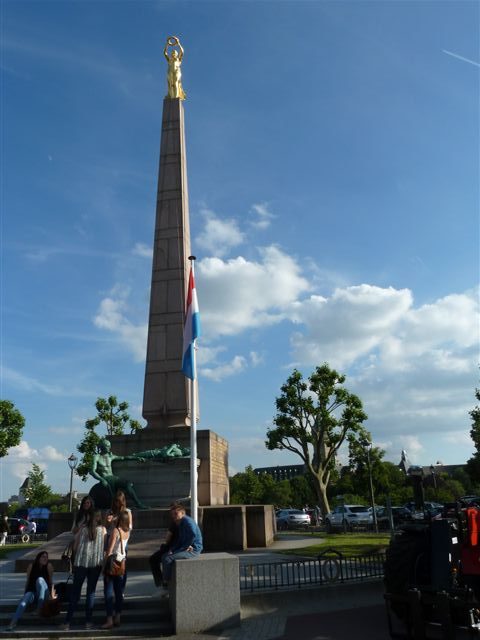Charming and romantic, you’ll find it hard to come across a more laid back capital city of the same name as the country writes John Newton.
While it doesn’t have the same wealth of attractions like its giant neighbours – France and Germany – Luxembourg, where French is the dominant language, has a rich cultural heritage and is pulling out all the stops to lure long-haul travellers, such as visitors from Asia, Australia and the United States, to the only Grand Duchy in the world.
First-time visitors head straight for the Grand Duke’s official residence – the grand-ducal palace – to see the changing of the guards, which happens every two hours in fine weather and every 40 minutes to one hour in snow or wintry weather. A late 16th century Spanish Renaissance-style building, the grand-ducal palace – with its conical shaped turrets that look like witches hats – served as a concert hall and tavern under the Nazi occupation of Luxembourg. It was not until 14 April 1945 that the people of Luxembourg could once again cheer Grand Duchess Charlotte on the palace balcony. The Grand Duke’s city residence is open to the public during the summer only, with guided tours from mid-July to September, except on Wednesdays.

A few hundred metres away in the heart of the city is Luxembourg’s ‘Golden Lady’. Called the Gelle Fra monument, it commemorates the thousands of Luxembourgers that volunteered for service in the armed forces during World War 11. Gelle Fra is the nickname given to the Monument of Remembrance, which is situated in Constitution Square – in the Ville Haute quarter of Luxembourg City. The centrepiece of the monument is a 21-metre tall granite obelisk on top of which stands a gilded bronze statue of a lady – representing Nike, goddess of victory or ‘Queen of Freedom’ holding out a laurel wreath as if placing it upon the head of the nation.

When Luxembourg was occupied by the Nazi forces in World War 11, the Germans dismantled the memorial in 1940. Several parts of the monument were rescued and, after the war, the monument was partially restored. However, the bronze statue (she’s painted in gold) of Gelle Fra herself was missing until 1980 when she was found hidden beneath the main stand of the national football stadium.
The monument was not fully reconstructed to its original design until 1984. Today, it symbolises freedom and resistance for the people of Luxembourg.
Another fascinating Old Town drawcard are the famous Bock Casemates – one of the most envied fortresses in Europe. Carved from the city’s rocks, the first casemates, or underground tunnels, were built in 1644, in the era of Spanish domination, with the enlargement of the 23-klometre long network of underground galleries taking place 40 years later under the direction of the military engineer and fortifications builder, Vauban, and later, in the 18 century by the Austrians. The fortress ramparts and the historically impressive Old Town were registered on the UNESCO World Heritage List in 1994.

From the Bock Promontory, there are panoramic views of the pretty riverside town of Grund, where you can visit the ancient Abbaye de Neumunster – transformed into a current cultural centre – or explore the cobblestone streets and take a walking break at Scott’s Pub bar.

For an insight into the changing day-to-day life of Luxembourg’s population – it currently stands around 590,000 – the city’s History Museum is home to a comprehensive permanent exhibition illustrates the country’s history that spans over a thousand years. The museum occupies four patrician houses, which were built from the 17th to the 19th century and still reveal some medieval structures. In just a few minutes, visitors are introduced to 1000 years of history as they pass the various layers of the city’s history – from the naked rock foundations on the lower levels to the panoramic views of the Grund and the Rham plateau on the upper levels.
The National Museum of History and Art, which showcases one of the most beautiful Roman mosaics north of the Alps, together with the city’s telecommunications museum, which has a remarkable collection of stamps, and the tram and bus museum are also worth a look.
With its close French connection, Luxembourg City is a gourmet’s delight, but you’ll have to be quick to beat the locals to the best tables which are taken most nights. While the prices will leave a hole in your wallet, you’ll find the food – and the wine selection – at fine dining restaurants, like the award-winning La Brassiere Guillaume overlooking the tree-lined main square, is as good as it gets anywhere in Europe, including Paris.
It seems a perfect fit for this splendid stress-free city with more than a touch of pomp and circumstance.
For further details on Luxembourg City, go to www.lcto.lu
Melbourne-based Rail Plus provided first-class rail travel in Europe, with the writer travelling to Luxembourg City from Vienna via Frankfurt and Koblenz. Choose from Eurail’s multi-country passes, single country, passes, Select pass, Global Flexi pass or Global Continuous pass. For first and second-class prices, plus expert staff advice on European rail travel, go to www.railplus.com.au
Feature supplied by: www.wtfmedia.com.au























Add Comment